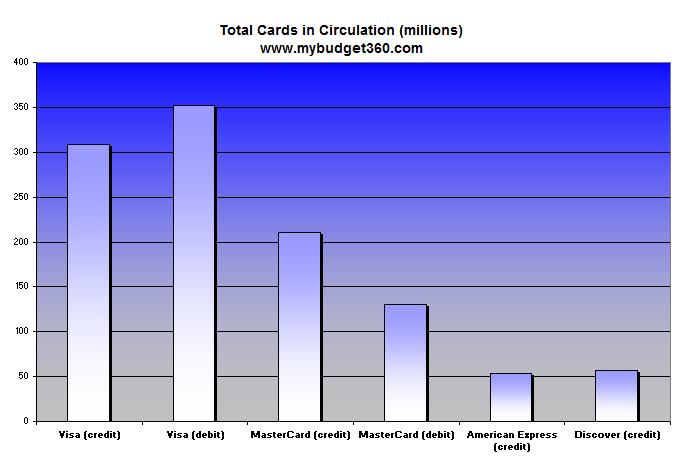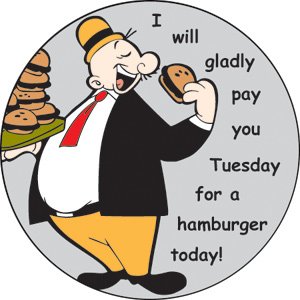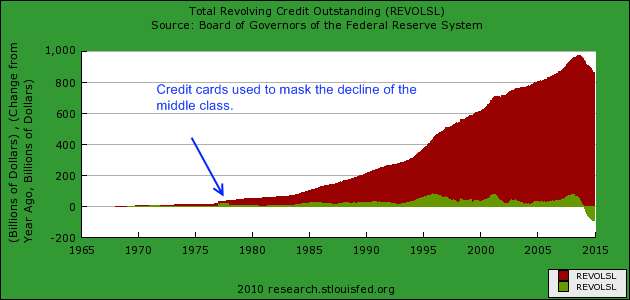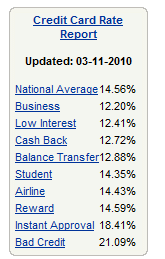631 Million Credit Cards for 113 Million Households – Credit Card Excess Contracting for First Time in 40 Years. How Plastic Hid Middle Class Financial Decay.
- 3 Comment
It is estimated that in 2010 we will have 181 million Americans carrying credit cards. Now this is interesting given that Census data from 2008 only shows 113 million households. The credit card is ubiquitous flowing through our economy like a river of easy money. Yet credit cards have become a major pitfall for many consumers. Hidden fees, double-cycle billing, and criminally high interest rates have pushed many Americans into financial tight corners. The credit card as it turns out is a dangerous financial item even if you can have a kitten screened onto the card.
If we want to understand the credit card industry we first should take a look at the most popular cards out on the market:
Source:Â Creditcards.com
In total there are 631 million credit cards in circulation from Visa, MasterCard, Discover, and American Express. Now given that we only have 308 million people in the U.S. many under the age of 16, many people have multiple credit cards. It doesn’t seem odd for people to spend and buy with basically creating debt with each purchase. The above chart also shows the amount of debit cards out in circulation. In fact, making debit cards virtually identical to credit cards has created a psychological notion that debit and credit are interchangeable. They are not. This is obvious but do anything enough times and you can easily convince yourself of anything including believing the idea that debt equals wealth. Debit cards access money you have while credit cards mortgage your future for a current item.
Americans are carrying an enormous amount of credit card debt. The massive spike in credit card debt started 40 years ago when the middle class started losing ground. You can almost mark the exact date when we started using credit to make up for the lost wage growth:
Since the early 1970s Nixon shock, Americans started losing their manufacturing base but also their ability to maintain competitive wages. In 1968 Americans carried $1.3 billion in revolving credit. By 2008 that number was up to $975 billion. Nonstop growth for nearly 40 years. Yet for the first time in over a generation this amount has fallen by a large number. Today, $864 billion in revolving debt is outstanding. Since the peak in 2008 we have seen consumer credit contract by a stunning $111 billion. For a consumption driven economy this does not bode well for economic growth since many Americans are finding it harder to spend in such a weak employment market.
As the U.S. Treasury and Federal Reserve they have artificially pushed interest rates to historical lows, but banks have decided to keep credit card rates at extremely high rates:
Source:Â Creditcards.com
How is it that the biggest beneficiaries from the Wall Street and banking bailouts are now able to charge such an outrageous margin on credit cards? These are the banks that received taxpayer assistance supposedly to create more access of credit for middle class Americans. We certainly are not seeing that. And who are the biggest credit card issuers?
U.S. general purpose credit card market share in 2008 based on outstandings
(Note: 2007 ranking in parentheses)
1. JPMorgan Chase – 21.22% (17.74%)
2. Bank of America – 19.25% (19.36%)
3. Citi – 12.35% (13.03%)
4. American Express – 10.19% (11.40%)
5. Capital One – 6.95% (6.95%)
6. Discover – 5.75% (5.65%)
7. Wells Fargo – 4.21% (3.07%)
8. HSBC – 3.47% (3.65%)
9. U.S. Bank – 2.14% (1.84%)
10. USAA Savings – 2.02% (2.01%)Source:Â Creditcards.com
The top four issuers corner a large portion of the market and are some of the biggest bailout recipients. The economy for most Americans still hasn’t recovered. Credit card defaults are simply a reflection of this reality. The fact that revolving credit has contracted so sharply in the face of $13 trillion in bank bailouts and support is only demonstrating that banks are unable to lend out money to consumers who can actually pay the money back. Banks also need the money to combat their weaker Swiss Cheese like balance sheet.
Most Americans can’t envision a marketplace with no credit cards. Many are now having to adjust to the new economic realities in the economy. Yet the fact that less revolving credit is in the market tells us consumers are pulling back on using their credit cards or banks are simply issuing less credit. In the end, middle class Americans simply cannot spend like they once did. Many are now realizing that they will have to save to purchase items and that isn’t necessarily bad. But with stagnant wages many are finding it hard to save and with no credit card access, dealing with realities that haven’t hit this country for a generation seems as surreal as believing that plastic is money.
If you enjoyed this post click here to subscribe to a complete feed and stay up to date with today’s challenging market!3 Comments on this post
Trackbacks
-
Sage said:
Am proud to say I have never used a credit card in my life. Have never even had one. Hate ’em. They are evil. Speaking of evil, also do not have a cell phone; never have. How’s that for a Luddite?
March 12th, 2010 at 8:54 am -
SB123 said:
Why all the complaining?
If you don’t agree with the terms of the card, just don’t use it!
Cancel your account and pay off what you owe. Real simple!
Quit the Entitlement Attitude: no one deserves a credit card and generations of Americans did just fine without using one.
March 13th, 2010 at 1:18 pm -
Fred said:
Obviously, Sage, you have a computer and interwebs. You are not completely free of sin. 😉
BTW, how many of those 618 million cards are in business names?
March 13th, 2010 at 9:53 pm




 If you enjoyed this post click here to subscribe to a complete feed and stay up to date with today’s challenging market!
If you enjoyed this post click here to subscribe to a complete feed and stay up to date with today’s challenging market!